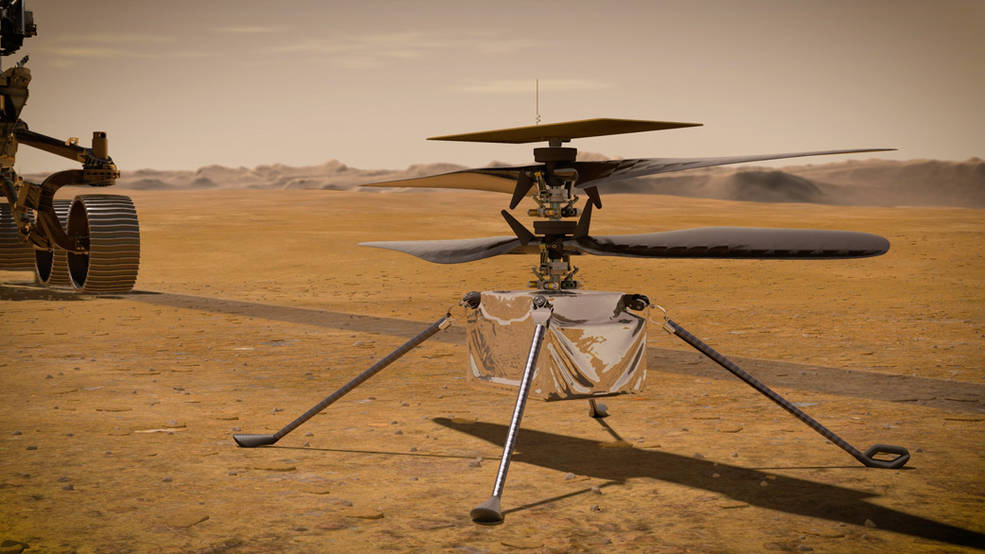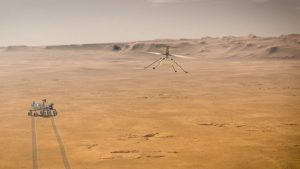Ingenuity – the Aptly Named Mars Helicopter

In this rendering, Ingenuity stands on the Red Planet’s surface as NASA’s Perseverance rover (partially visible on the left) rolls away. Credits: NASA/JPL-Caltech
July 28, 2020 – When NASA’s Mars 2020 Perseverance Rover launches from Cape Canaveral Air Force Station this week, a 4 lb (1.8 kilogram) super-duper, innovative miniature flying machine will be riding along. It’s name is Ingenuity—and it’s a marvel of engineering. Ingenuity is designed to be the first aircraft to attempt controlled flight on another planet. Developed at NASA’s Jet Propulsion Laboratory, there were many hurdles to climb in creating this helicopter with 4 carbon-fiber blades arranged into two rotors that spin in opposite directions and at around 24,00 rpms, many times faster than a passenger helicopter needs to spin in Earth’s atmosphere. Mars atmosphere is 99% less dense than Earth’s, so beyond the custom blades and high-speed spinning, Ingenuity has to be light, as the thin atmosphere on Mars makes it difficult to achieve lift.

When Ingenuity attempts its first test flight on the Red Planet, the Perseverance rover will be close by, as seen in this artist’s concept. Credits: NASA/JPL-Caltech
Additionally, Ingenuity will face extreme cold with nights to minus 130 degrees Fahrenheit (minus 90 degrees Celsius). The cold will push the design limits of many of Ingenuity’s parts. If that isn’t challenge enough, communications delays are the norm, so commands will need to be sent well in advance, and data coming back will lag. So little Ingenuity has to be equipped to make its own decisions about how to fly to a waypoint, keep itself warm, and charge itself with its solar panel. Ingenuity is considered a technology demonstration, seeking to test a new capability—a very significant mission but with limited scope. And while Ingenuity has already survived many tests on Earth in simulated conditions, the real tests will begin in February 2021 when Perseverance lands with Ingenuity attached to its belly.
The scientists and engineers working to develop Ingenuity have been working on aspects of this special project for years, testing progressively more advanced models at JPL. In January 2019, the actual helicopter that is riding with Perseverance to the Red Planet, passed its final flight evaluation.
“The Wright Brothers showed that powered flight in Earth’s atmosphere was possible, using an experimental aircraft,” said Håvard Grip, Ingenuity’s chief pilot at NASA’s Jet Propulsion Laboratory in Southern California. “With Ingenuity, we’re trying to do the same for Mars.”
How Ingenuity got its name: High school student, Vaneeza Rupani, Northport, Alabama, originally submitted the name Ingenuity for the Mars 2020 rover, before it was named Perseverance, but NASA officials recognized the submission as a terrific name for the helicopter, given how much creative thinking the team employed to get the mission off the ground.
“The ingenuity and brilliance of people working hard to overcome the challenges of interplanetary travel are what allow us all to experience the wonders of space exploration,” Rupani wrote. “Ingenuity is what allows people to accomplish amazing things.”
What’s Next for Ingenuity
1. Surviving the launch from Cape Canaveral, the cruise to Mars, and landing on the Red Planet
2. Safely deploying to the surface from Perseverance’s belly
3. Autonomously keeping warm through the intensely cold Martian nights
4. Autonomously charging itself with its solar panel
5. Making its first flight attempt
If the helicopter succeeds in that first flight, Ingenuity will attempt up to four other test flights within a 30-Martian-day (31-Earth-day) window.
If this ambitious mission is successful, it could enable other advanced robotic flying vehicles for future robotic and human missions to Mars. The overhead viewpoint could provide information not provided by on-the-ground rovers and landers, provide high-definition images, and enable access to terrain that is difficult for rovers to reach.
Watch the launch, currently scheduled for Thursday July 30 AT 7:50 AM. Keep an eye on this link for any changes in the launch schedule.
In town? Get your EPIC LAUNCH VIEWING map.
SOURCE: NASA
For more information about Ingenuity.
Information is also available on Ingenuity’s web page.







